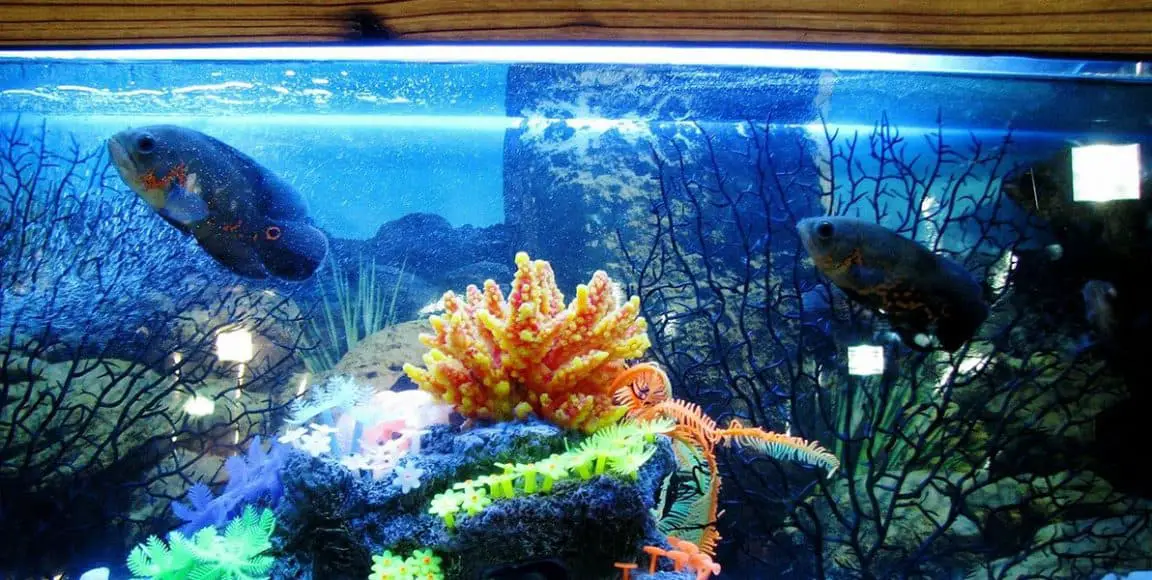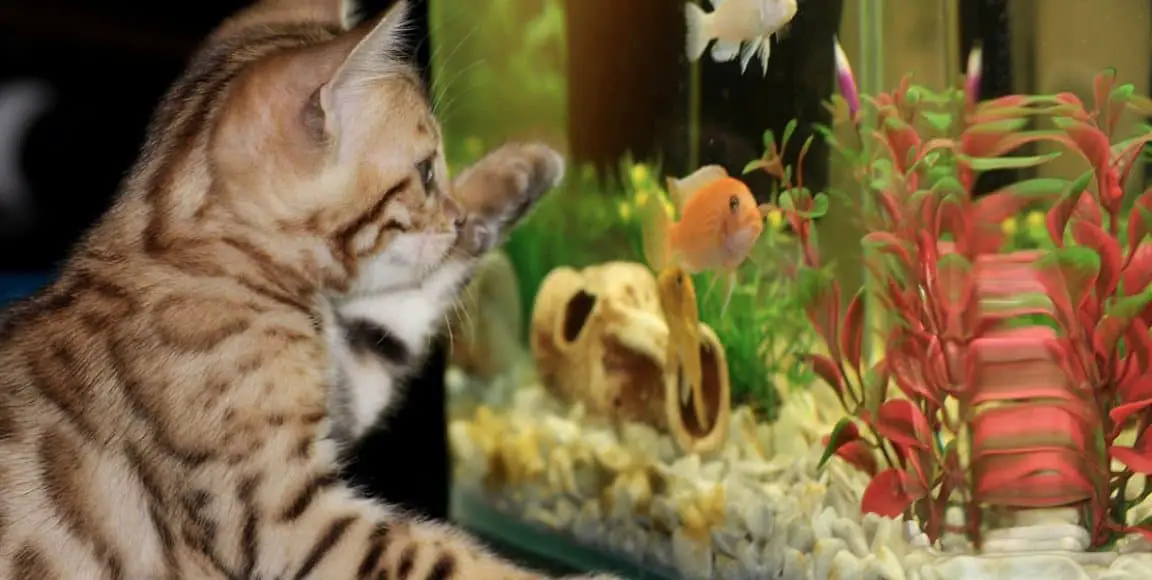Last Updated on January 10, 2022
Have you ever wanted to get a fish tank but don’t know where to start?
Setting up a fish tank for the first time is not as easy as it sounds. There are all sorts of things to consider before you get started like what type of pet do you want, how many gallons should the tank be, and what equipment will your new pets need?
Fish tanks are a great way to bring some life into your home and provide your pet with the best home they could have. There’s no need for any crazy equipment or huge budgets – just read through this beginner’s guide before getting started to get the most out of your new hobby.
You might not all be expert fish keepers yet, but you have the potential to become one so let’s get started!

Table of Contents
What is a starter fish tank?
A starter fish tank is a great way to get introduced to the world of fish keeping. It’s also an affordable and simple option for those who are looking into getting their first aquarium but don’t want to spend too much money or time on it.
You can buy this at your local pet store or online and is designed to make your setting up easier. There are starter fish tank kits that come with this product and generally includes:
Glass or acrylic tank
You may get either a glass or acrylic type in your starter fish tank. The only difference between the two is that aside from being cheaper, the glass aquarium is sturdy, scratch-resistant, and maintains its clarity over time.
Meanwhile, the acrylic aquarium is often more expensive due to its lighter weight and being sturdier. However, this type of tank gets scratched easily making the cleaning process more challenging, especially when wiping algae from the surface.
Filtration system
Responsible for keeping the water clean, the filter in your aquarium cleans the water your fish breathes in. The best aquarium filters do the job done on processing the three types of wastes:
- Solid wastes like leftover food, fish feces, dirt, and any debris floating are the type of waste that is removed through mechanical filtration. However, it is important to know that mechanical filtration alone is not enough to remove other chemicals like ammonia, nitrate, and nitrate.
- A chemical filtration system removes dissolved wastes such as decaying tissue in tap water that causes odor and discoloration of the water tank.
- Contaminants like ammonia and nitrate are called biological waste. This type of waste has to be processed biologically rather than filtered and is removed through the biological filtration system.
Heater and thermometer
The temperature of your aquarium is essential in sustaining your cold-blooded pet’s body temperature. Since fish don’t produce their own body heat, having a heater and thermometer at the same time is very important in fish keeping.
Keep in mind that the average temperature that is ideal for freshwater tropical fish is 78 degrees Fahrenheit.
Lighting
The average light in a freshwater fish tank is usually between 5,500 and 8,000 Kelvin which can be adjusted depending on the type of aquarium.
You can see why it’s important to have the correct lights in your tank, especially if you want live plants. If not enough blue light is supplied, algae will start growing all over and ruin everything! The best way to enjoy aquarium life without any problems or complications is by investing in a good set of lights for your fish tank.
Let your local dealer know your tank’s height and the types of plants you want to keep when getting advice on the best light fixture for a custom aquarium.
Aquarium substrate
Substrates are used to cover the bottom of the tank. There are so many different types of substrate materials and colors to choose from when setting up an aquarium.
It also serves several purposes. Some are key to a healthy habitat, while others are merely aesthetic. Gravel also acts as a site where beneficial bacteria can grow which breaks down waste products from fish in order to keep their environment clean.
Some people may prefer the natural look, while others might want something a little more exotic in order to attract fish they don’t have yet!
Related: 7 Best Gravel for Betta Fish in the Tank
Decorations like artificial plants
Generally, silk or plastic plants are included in a starter tank rather than real plants. Unlike live plants, they will not die or grow too large. If they become dirty or covered with algae, you can easily remove and clean them!
Before deciding to get a starter tank kit, keep in mind to research the type and species of fish you want to keep first to accommodate their needs. Keeping a goldfish for example doesn’t necessarily require a heater since they are a temperate fish. Some freshwater and tropical fish on the other hand, like the betta and tetra, need one to sustain their necessary temperature.
Best gallon tank for your pets
The first thing you need to consider in choosing a tank is its size. Starting with a smaller tank might be the best choice for beginners since it’s easier to clean than the larger ones. Although this may be true, larger tank size is more preferable to a smaller aquarium due to a number of reasons.
First is the more water you have, the easier it is to maintain the balance of your fish’s environment. Essentially, larger tanks contain a large volume of water which is less prone to unstable water parameters, unlike the smaller ones. This means that choosing larger over smaller tanks will be less maintenance for you and healthy water quality for your fish.
Another reason is that fishes thrive more in a wide, spacious ecosystem and this is only possible if you give them enough space to swim around. With that being said, it is recommended to start with a 20-gallon tank (or larger) and not less than a 5-gallon tank.
Where to keep your new aquarium?
When you’re deciding on the best place to keep your fish tank, there are many factors to consider. For example:
- Is there enough space in your room where the tank is out of reach from children or other pets?
- Place the aquarium well away from direct sunlight, heaters, aircon units so that your fish don’t suffer from temperature shock.
- Be sure to keep the tank away from any open windows or any cold, enclosed space. The slightest breeze can cause an aquarium’s water temperature to fluctuate, which could stress your fish and stop plant growth!
- Power outlets should be easily accessible for the heater, filter, lighting unit, and other accessories requiring electricity. Make sure though to neatly keep the cables to prevent tripping over them.
- If you want your aquarium to be stable, make sure that the floor is level underneath it. If there are any slopes or bumps in the ground around where you’re going to place it, this will cause instability and uneven pressure that might lead to leaks and cracks from all of those uneven weights like water (and substrate too)!
Once you’ve decided where to keep your tank, measure the space so that you’ll know what aquarium size can fit. Then think about choosing a fish species accordingly because now it’s possible!

How do you set up a fish tank for the first time?
Setting up an aquarium for the very first time may seem to be quite intimidating. But don’t worry, here is the step-by-step process you need to know in assembling your aquarium before you add fish to your aquarium.
1. Cleaning the gravel
You want to make sure to wash your gravel before adding it to the aquarium. Not washing it at first can lead to your tank becoming cloudy for weeks.
One of the best ways to clean your gravel is by using a high-pressure hose. Use it directly in the bucket and fill vigorously until you’re tired out, then wash thoroughly with circular movements before removing dirty water from the bucket while keeping substrate at the bottom.
Repeat this process 4 or 5 times for maximum results! Some substrates will continue to cloud after cleaning so don’t worry if they do – after all, some silty bedding can naturally settle over time anyway.
2. Placing the substrate
With the help of a bucket or scoop, slowly pour your clean gravel into the bottom. This will keep it from damaging any glass at the top and it’ll also stop all that fine sand you just put in there from spilling out everywhere.
The trick is to make sure you have enough so when you go on to lay down your substrate layer later, everything’s nice and even- about 1/2 inch thick should do nicely!
And then start smoothing things with your hands while making some dips here and there for good measure: this creates an illusion of depth which gives the aquarium a pretty neat perspective altogether!
3. Filling up the aquarium
It’s time to fill up your aquarium with water using a hose pipe or a bucket.
After filling it up, use a dechlorinator. Although there aren’t any fish yet, chlorine and chloramines can build up over time. You’ll need to invest in a quality product for the life of your tank because it will be necessary every time you do a water change.
4. Filter material
Make sure to gently clean your filter material under the tap or in a bucket before placing it inside the aquarium. This may contain debris or dust as they have been stored on shelves.
Start your filter by manually filling up the reservoir or, if you have a hang-on model, use its handle to adjust the water flow as needed. For cycling purposes, set it at high and for regular maintenance, at low.
5. Heating and lighting
You should always have two heaters in your aquarium, but if there isn’t enough space for one then it’s okay to use a smaller heater that will fit inside the tank.
If you’re on a budget and want maximum efficiency from your heater (because heating solutions are expensive), go with higher wattage models which will save energy while also reducing wear-and-tear on the device itself.
Place the heater to the glass and set the temperature between 74 and 80 degrees Fahrenheit. Aside from this, place the light on or above the tank and set its timer for no more than 8 hours a day.
6. Cycling
Before finally adding fish to your aquarium, the last process is the cycle stage. Cycling your tank’s water is important in making sure that you are providing your fish with the best and a healthy environment. There are test kits available in your local store that can help test your water quality.
Moreover, the cycling process will help prevent any untimely and unnecessary death in your aquarium’s inhabitants.
Related: Betta Fish Aquarium Setup: All You Need To Know

Choosing the right type of fish for your tank
There are many fish and species to choose from that you can make as your first inhabitants. However, it is best to research the compatibility of different species to make sure that you are building a peaceful community for them.
It’s important to start your fish off right by adding just a few recommended species at first and gradually introducing more over the next four-six weeks.
To do so, choose only those that appear active and healthy, while also taking special care not to overcrowd your aquarium where fewer healthier ones are better than plenty of stressed-out ones.
Remember also to feed your fish with a sufficient amount only at least twice a day. Overfeeding is never recommended as this may cause more problems than good.
Related: What is the Best Betta Fish Tank Available?
How do you maintain an aquarium?
The recommended aquarium maintenance can be scheduled daily, weekly, bi-weekly, or monthly.
Daily
- Make sure if the equipment is working properly.
- Check your fish’s behavior during feeding. Behavioral changes may be an indicator of potential illness or problem.
Weekly
- Count if the number of your fish is still complete. In case of death, smaller species like the tetra can decompose quickly which can result in ammonia and nitrite spikes resulting in high nitrate levels.
Every other week
- Test the aquarium’s water parameters such as pH, carbonate hardness, nitrite, and nitrate.
- Clean the aquarium walls by starting from the bottom to the surface.
- Vacuum or wash the gravel.
- Change 10-15% of the water.
- Rinse filter cartridge.
Monthly
- Replace filter materials and rinse the entire filter if needed.
- Maintain the power and quality of your water system by performing a routine inspection. Inspect tubing, connections, airstones, skimmers, and other parts for proper operation.
- Clean the top of your aquarium to check that lighting is not affected.
- It is important to stay on top of the expiration date for any aquarium equipment you purchase. If it has expired, then your test results will be incorrect and may lead to unnecessary actions being done by yourself or others in an effort to correct things that otherwise would not have been needed.
Related: How Often Do You Clean A Betta Fish Tank
In conclusion
Fish are great pets! Now that you have the basic ideas of keeping fish such as choosing the right size or shape of the aquarium for your home and tips about which filter works best depending on whether you have freshwater or saltwater fish, it is now time to decide on what kind of tank, equipment, and type of fish you need to start with.
We hope this post has helped clear some things up if any confusion arose when thinking about setting up a new fish tank in your home.
